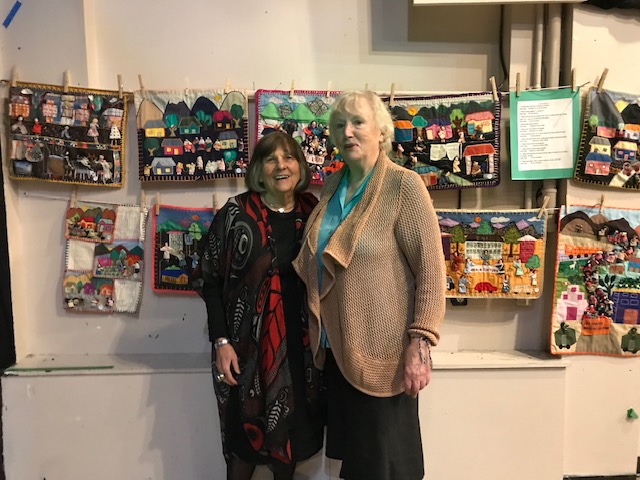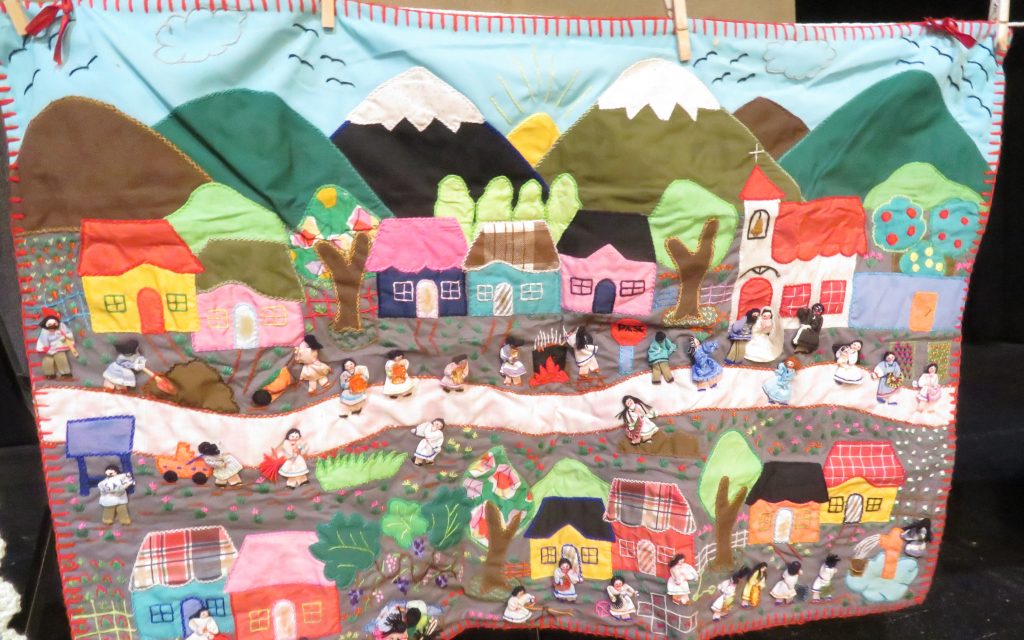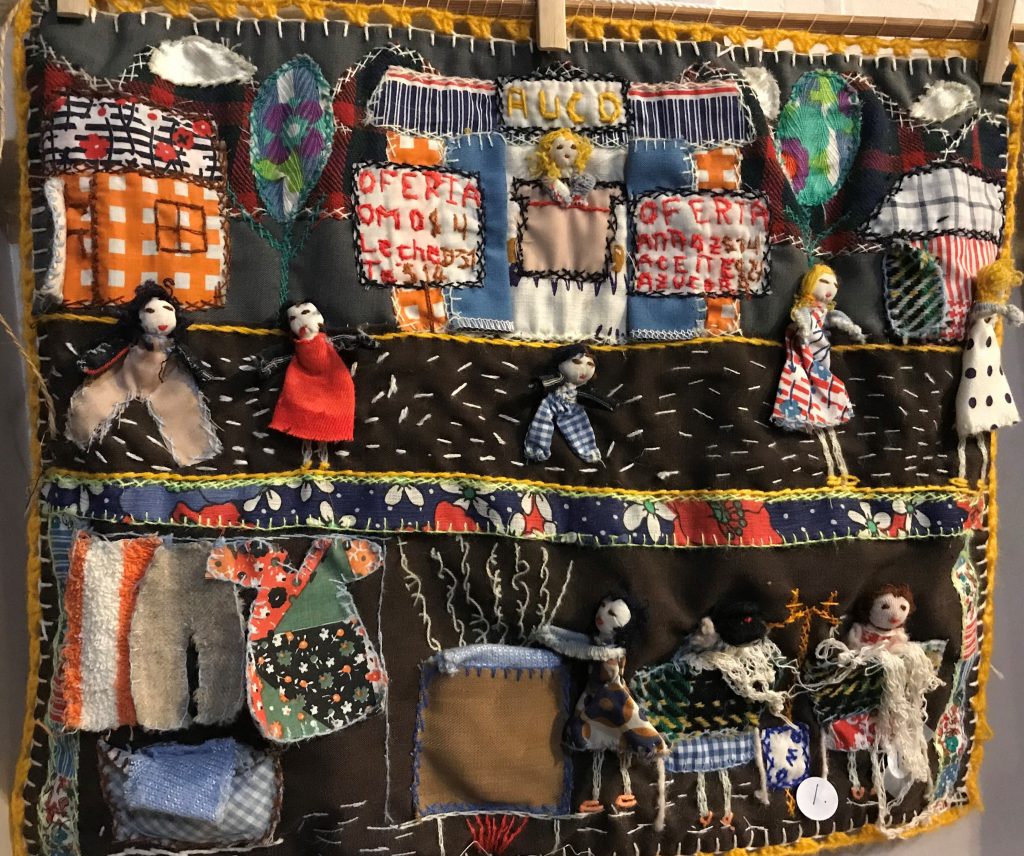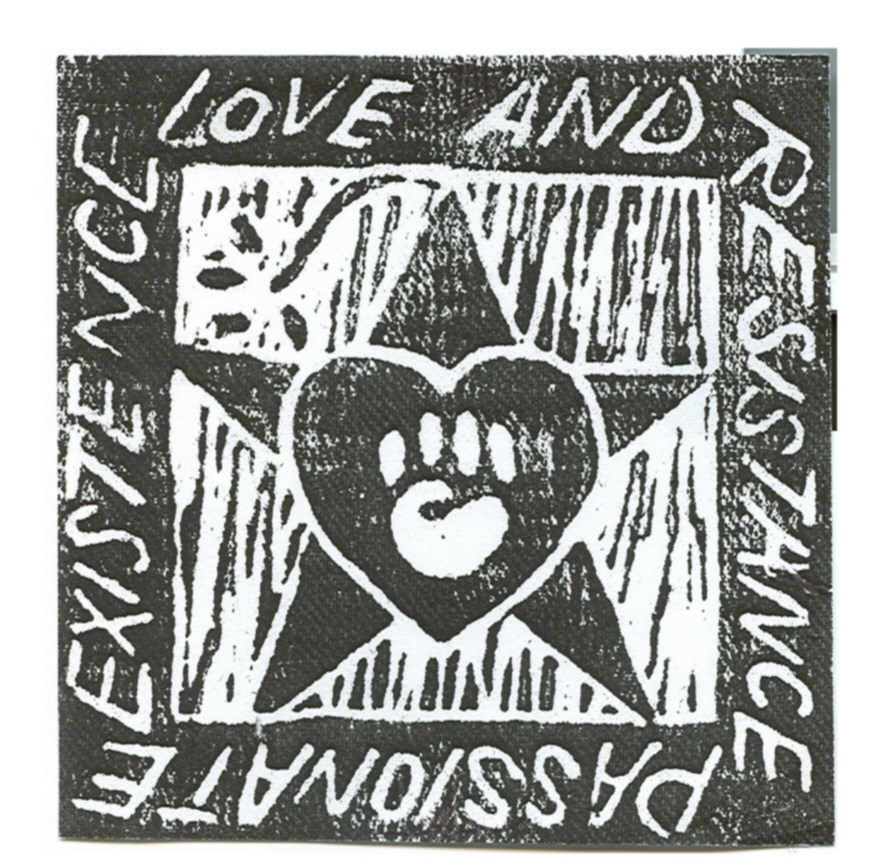Arpilleras: The textile art of resistance from Chile
Café Simpatico, Vicotria BC. Frbruary 28, 2020
A presentation by Theresa Wolfwood
For The Victoria Central America Support Committee
& the Barnard-Boecker Centre Foundation
We thank the Songhees and Esquimalt people for sharing the unceded territory with us.
The Story of Arpilleras
Arpilleras are appliqued and embroidered textile tapestries originating in Chile. The name comes from the Spanish word for sack; arpilleristas use flour sacks to back their works and the word became their name. Some arpilleras were made in Chile before the Pinochet but arpilleras as we know them became a worldwide art form during the Pinochet regime.
Poor women from the barrios of cities like Santiago came together under the protection of the Catholic Church to make these tapestries for export. They were an important income source, a message to the world about their condition under harsh dictatorship and a form of community and commination among themselves. Because they were looked down on as folk craft made of bits of fabric (from old clothes, often those of the disappeared), arpilleras were able to be sent out to the world with their beauty and stories uncensored.
Roberta Bacic, an expert and international curator of arpilleras, has written,
“In every step of their journey, the arpilleras have demonstrated resistance; resistance against poverty by creating a grassroots export; resistance against repressive regimes by narrating the story of daily life under such regimes; resistance against the very idea of non- resistance by making sewing an act of subversion; and resistance against the expectations of the art world by being exhibited as if they are works of classical art.”
Arpilleras from Chile continue to be made documenting injustice and life today. The art form has spread to other countries and cultures as artists create their own versions of the arpilleras to tell their stories.
“…female fiber art has often been crafted to explore social issues and inspire change for the benefit of their communities and the world.”
Creations in fiber are not only ‘a worthy art form’; they are also a lasting testament to the enduring power of women and an important archive in the history of resistance to injustice and violence.
Arpilleras are now exhibited and collected by major art institutions around the world, including at the “Disobedient Objects” show at the Victoria and albert Museum in London and recently at the Tate in London..
“The threads, the scraps pf cloth, the wool, the lace, and the stitching are all manifestations of beauty, courage, and the possibility to embroider the world with grace and light.”
Thanks to all those who kindly shared their treasures for us to see. Roberta Bacic is an unending source of inspiration, knowledge and support for arpilleristas and all those who love this “Art of Resistance
All quotes from:. Stitching Resistance: Women, Creativity, and Fiber Arts. Marjorie Agosín, editor. Solis Press 2014. Tunbridge Wells, Kent, England ISBN 978-1-907947-90-2


At the beginning of the presentation Nedjo Rogers sang and played the guitar including ng a song by Victor Jara.
He was followed by the showing of these videos
Roberta Bacic expelling the art of the arpilleristas: https://cain.ulster.ac.uk/quilts/interview.html
Roberta Bacic giving a workshop in Zimbabawe : https://www.youtube.com/watch?v=hL3EmdCs5sM
A slide sow of Arpilleras of the world with commentary followed; it may be seen on the YouTube link below. This poem was read at the end of the slideshow


The arpilleristas
It is love that sustains their every stitch.
Broken and shattered by loss and murder, daily poverty
to fuel massive wealth weighted by warehouse of weapons
And phalanxes of brutalized young men.
Women search for a tomato, a beef bone, a scrap of fish.
They scrub floors on bony knees.
Always under aprons an image
of a disappeared beloved,
against still beating, still waiting hearts.
Arpilleristas sew with scraps of clothing not worn now,
only scented with memories of happier times.
They open their veins to find thread to sew reality.
Strip sinews to letter a banner :
Donde Estan?
In frozen moments of rest
their silent needles pierce the sacking,
re-create lost families, show the world their life
of soup kitchens, communal bread ovens, stolen electricity,
they create with anger and sadness
rallies to show their resistance,
they harvest their dreams of peace
with fruit trees bearing in abundance
For all who share the gathering
in little happy figures fastened
against unending sunrises over the Andes,
they stitch that courage is always possible.
Their hope renews every day
in the chilled morning sunrise.
Love never sets in the evening ocean.
Life with the disappeared continues.
Their faith embroiders
perpetual remembrance
on gentle arpilleras. tjw
from LOVE AND RESISTANCE 2014. Smallberry Press, London. UK


The present situation in Chile
Chile in Revolt: ‘It’s Not about 30 Pesos, It’s about 30 Years’
In October, 2019 Chilean President Billionaire Sebastián Piñera, proclaimed that “in the midst of this turbulent Latin America, our country is a true oasis.”
Six days later, high school students in the capital city, Santiago, began a protest against the rising cost of public transit through mass fare evasions. Protest spread throughout the country and broadened to demands for basic rights ; Piñera himself repeated on television the phrase w which the dictator Augusto Pinochet had used, “We are at war.”
People demoded more than a reduction in transit fares; they demanded a new constitution; the country was still being ruled after thirty years by the constitution Pimochet had enshrined. A constitution with no expression of human rights, the privatization of services, healthcare and education was enacted: Chile has rightly been characterized as the world’s first laboratory of neoliberalism, the free-market ideology of cutting regulations, slashing public services, and privatizing everything, ,including public services and pensions.
In October a massive demonstration of 1.2 million people peacefully gathered in Santiago to call for a new constitution to be created by a people’s assembly. The reprisals’ began with police and military action. 7000 people were arrested; thousands have been injured and most heinous, e eyes of activists are targets. Almost 44 people have lost their sight. Eyes have become a symbolic image in all demonstrations and appear in arpilleras made at this time.
Chileans are determined to have a just constitution (so far the government has said it will hold a referendum on having a new constitution) with rights and freedom for all people, public services, a decent living minimum wage and pensions.
1 percent of the population has accumulated more than a quarter of the country’s wealth. The slogan of the revolt quickly became—referring to the subway fare hike—“It’s not about 30 pesos; it’s about 30 years.”
The protests have not only been about economic inequality, but also about long-standing questions of social justice and the legitimacy of the government in the post-Pinochet era.
We hear little about Chile from our government and media – perhaps because Canadian corporations, mainly mining companies, are profiting from the neoliberal regime.
Chile’s military has taken over security in Santiago, now under a state of emergency with night-time curfews as 20,000 soldiers patrol the streets.
In March 2020, for International Women’s Day, there were demonstrations of women calling for equality and an end to violence – the biggest demonstration was in Chie.
La Lucha Viva
At the end of the presentation we were inspired by this video of people singing Victor Jara’’s songs in the square of San Diego Chile in October, 2019
See: https://www.youtube.com/watch?v=V_xRSfjCyrg
References
ARPILLERAS
Books:
Stitching Resistance: Women, Creativity and Fiber Arts Edited by Marjorie Agosin
Publisher: Solis Press UK
We, Chile: Personal Testimonies of the Chilean Arpilleristas Edited by Emma Sepulveda Publisher: Azul Editions; USA
Scraps of Life: Chilean Arpilleras by Marjorie Agosin . publisher: William Wallace, Canada
Disobedient Objects by Catherine Flood and Gavin Grindon. Publisher: Victoria and Albert Museum. UK
Websites:
https://stitchedvoices.wordpress.com/2017/11/01/conflict-textiles-meaning-and-interpretation/
https://cain.ulster.ac.uk/conflicttextiles/
Chile Today
Websites:
https://www.counterpunch.org g/2020/02/05/the-dramatic-fall-of-chile-as-latin-americas-neoliberal-role-model/
https://www.aljazeera.com/news/2019/12/chile-protests-2-months-ready-continue-191218150734536.html
https://www.theguardian.com/world/2019/dec/17/chile-mental-health-protests-uncertainty
https://consortiumnews.com/2020/03/02/chiles-us-backed-govt-shooting-anti-austerity-protesters-blinding-maiming-by-the-thousands/?fbclid=IwAR2DGrX1uGE0waG-IWOWbUg8yjb2DJjmJotGpnzniiKe1sGRkOhe_xo02fA


Closing of Presentation
We again thank the Esquimalt-Songhees people for generously sharing this beautiful land with us.
To all those who helped prepare, set up and present this event~ and to Efren Quinoz, videographer; Craig Armour and Kealey Pringle, photographers
~ many thanks~
Social change is always a group process.
Thanks to the following for kindly lending their art for this exhibition:
Co-Development Canada; Janet and Steve Gray; Kirsti Kolthof; Eva and Jim Manly; Margo Matwychuk; Carmen Miranda; Cathy Talbot; David Talbot and Ann Young
Dedicated to the people of Chile and their struggle for justice

Action is the Mother of Hope ~ Pablo Neruda
An edited version of the presentation may be viewed at:
Gracias


